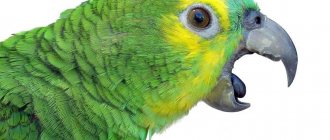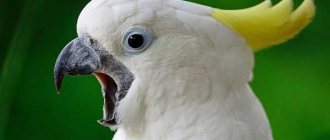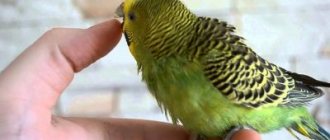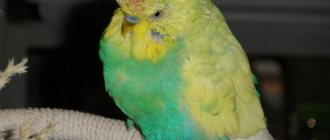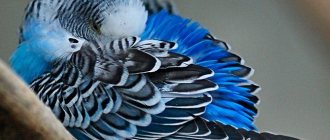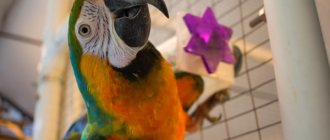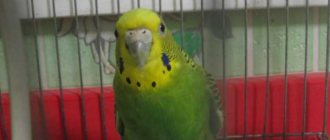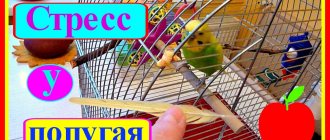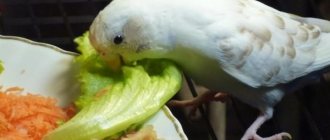Curious, cheerful, energetic - all these epithets belong to pet parrots. They give a lot of positive things, and against this background the real problem seems incredible: how to wean a parrot from biting. However, daily attacks by birds on their owners are not uncommon. Because of this behavior, discomfort arises in people, but even more so in birds, who have to live indoors, without games or walks. You will learn from the article how to understand why a tame parrot bites and how to stop it.
Why does a parrot bite?
To eliminate a bad habit in a pet, you first need to understand the peculiarities of its behavior. In the wild, it uses its beak to move along tree branches, get food and communicate with relatives. In captivity, a feathered pet bites for the following reasons:
- character traits;
- territory protection;
- fear;
- mating season and hormonal changes;
- health problems or shedding.
The main reasons why parrots bite
Yawns very widely
The reasons for this behavior in cockatiels are:
- The bird is trying to get more oxygen.
- Gets rid of ear plugs.
- Clears throat due to allergies or dust.
However, if a yawn is accompanied by excessive head bobbing, don't ignore it. If this is the case, your cockatiel may have problems with its nostrils, an infection, or some other respiratory illness. However, if the bird's feet are warm, it means it is healthy. Cool paws are a sign that the bird is sad, afraid of something, or sick.
Thus, to really understand what a cockatiel's personality is and what its behavior means, you need to spend a lot of time with the parrot. Chat with him, play, take care of him. Then you will gain trust and love. However, if your pet is behaving strangely or abnormally, do not hesitate to contact an experienced ornithologist.
At some point, your affectionate feathered pet tried to bite you. Is it worth sounding the alarm and taking care of education to avoid aggression from the bird? First, let's look at the reasons for this behavior.
The beak of parrots is incredibly sensitive, it is covered with nerve endings, and therefore especially young chicks love to touch, taste, and thus get acquainted with the world around them.
Photo: Pieter van Marion
If the bird is in a good mood, it rubs its beak on the rods and perches, and when something upsets or angers it, it uses the same method to throw out its emotions.
Home protection
If a bird notices a hand in its cage, it perceives it as a direct threat. The pet does not recognize the finger, but sees a hostile subject who is furiously encroaching on its territory. Through aggressive actions, the bird protects its home from unwanted interference. When your pet is alone or resting in a cage, do not interfere with it. Food and water can be replaced at other times.
Read also
The parrot crows and hides its head in feathers
Startle response
Stress and fear force your pet to defend itself. In the wild, a bird has two options to avoid danger: defend itself with its beak or run away. Under natural conditions, birds often prefer to hide from their pursuer. A pet is deprived of such a chance and the only way out for it is to bite.
Fear of a parrot is one of the reasons for its bites
As practice shows, the owner often does not even know the reason for the shock in his feathered friend. The source that causes fear in a pet can be a running vacuum cleaner or air conditioner. When a pet is frightened, it hisses threateningly and extends its head towards an object or person.
If the parrot is recently purchased, there is a high chance that the new owner will be bitten. Once in an unexplored apartment, he does not make contact with the person. Therefore, it is advisable to wait a little while getting acquainted. Before picking up a bird, it needs to be given time to adapt to its new environment.
Shedding or illness
When a pet feels unwell, it does not want to have contact with a person. If the bird is in this condition, it is better not to disturb it, otherwise you may get a painful bite.
Owners of parrots often notice how birds become more aggressive during the molting period. This is explained by the fact that during the appearance of new plumage, the pet’s skin is very itchy. During this period, it is not recommended to pester him to avoid unpleasant consequences.
Lack of minerals in the body
When you feel that your body is lacking something, for example, your nails and hair are breaking and your skin is becoming dull, then you go and buy the appropriate vitamins and minerals. But our pet cannot even understand for himself what exactly he wants, but the body requires something that is not in the diet. Then their appetite is distorted, and they begin to gnaw on everything nearby. There is a lot of information on each species of parrot and their daily nutritional needs. By familiarizing yourself with them and supplementing the diet with the necessary elements, you will not only solve the problem of property damage, but also significantly improve the quality of life of your bird.
How to stop a parrot from biting?
It is possible to discourage a bad habit; the main thing is to follow the recommendations and under no circumstances respond to your feathered pet’s misdeeds with aggression.
Read also
How to teach a lovebird to talk
Retrain a budgerigar
- Immediately after the bite, firmly and clearly, but without going into a scream, say: “You can’t!” Budgerigars respond well to human intonation. Your actions should demonstrate that you are unhappy with his aggressive behavior.
- Try to win the favor of your pet. Watch his behavior carefully. Remember what games and treats your pet prefers. If he behaved well, praise him and treat him to his favorite food.
- When a chick, sitting on your hand, bites, lightly jerk it so that the feathered bully loses his balance, but in no case falls.
- You cannot punish physically (sharply throw it away, hit or push), most likely the pet will not even understand why he is being punished, will be scared and will harbor a grudge.
How to stop a parrot from biting
Methods
Before you start taming a parrot, be prepared for the fact that for a successful result you will have to spend a lot of personal time. No haste or pressure on the bird is acceptable; any actions should strengthen trust and not destroy it. For the first 2-3 days after the purchase, the parrot is confused and scared, sits silently, is ruffled and quietly sad. This is fine. Leave the bird alone these days.
By nature, parrots are very sociable, so even the most stubborn of them will not sit in the corner of the cage alone for a long time. After a couple of days, the pet will recover a little from stress, will stop rushing to the far corner of the cage when you appear, and will begin to peck food from the feeder when you are in the room. Now you can begin to accustom him to your hands.
Ornithologists suggest following gradual steps in taming.
- First, try to interest your pet in communication. At first, do not come close to the cage and talk to the bird from a distance in an even, soft voice, calling the pet’s name. Then begin to slowly approach the cage so that the bird understands that you are addressing it. Observe your parrot's gestures to see if he is listening to the sounds of your voice. Be prepared to perform this initial stage especially carefully, show maximum patience and do not rush to move on to more active actions.
- Through observation, determine what your parrot likes to eat most. See what he chooses from the feeder first (grain, fruit, nuts, something else). During taming, do not put this food in the feeder, but use it as a treat to encourage the parrot during training.
- For the first time, try to grab just a little bit of your favorite food with your fingers in a pinch and offer it through the bars of the cage. There is no point in opening the cage door and rushing to put your hand inside - the parrot is not yet ready for this. Most likely, he will not take food the first time even through the bars. Don't insist, wait a few minutes and move away from the cage. Offer the treat a second time before feeding again. Perhaps a hungry bird will take a treat. As soon as this happens, praise him in a kind voice and additionally reward him with a treat. Do this step several times.
- After about a week, you can offer treats by hand through the door. Place the treat in your open palm and wait. Calmly continue talking to the bird, don’t rush it, don’t try to convince it to eat the “yummy” food. Wait until the pet decides to approach the hand. This should be done in the morning, when the parrot is alert and hungry. There is no need to extend your hands far into the cage, since at first all parrots are afraid of hands, but this will pass. Do this patiently every day.
- The moment will come when the bird itself will take food from the palm. First, he will grab a grain or nut, bounce from the hand to the far corner of the cage and enjoy the treat in a safe area. Remain calm, do not be nervous, once again be patient and do not scold the bird under any circumstances. The parrot will soon understand that there is no danger, you are not trying to take away the food or grab it. After some time, he will boldly sit in your arms and enjoy the treat without moving deeper into the cage.
- Now you can train your bird to sit on your finger. Place your outstretched finger on the perch where your pet likes to sit. Usually this is enough - the parrot itself jumps onto the finger. But sometimes he simply does not understand what is needed from him. Touch the feathers on the belly in front between the legs, and the parrot will quickly sit on your finger.
We invite you to familiarize yourself with the Budgerigar - a talkative tenor. Description and photo of budgerigars During the training process, it sometimes happens that some parrots cannot be tamed. Don’t deviate from your plan, find another way to interest the bird. You can try to accustom your pet to your hand using a small mirror. Quietly move the mirror in front of the bird, bringing it closer to your open palm and moving it away from the bird.
Special care is required on your part. No sudden movements or hasty gestures, do not risk losing trust. Instead of a mirror, there may be another object - a pen cap, a bottle cap, a new toy - parrots love to tinker with such things. If you manage to find an object that interests the bird, the rest will depend on your desire for success, the sequence of your actions, and everything will certainly work out.
Taming the cockatiel
- For the first couple of weeks, you should not enter the bird’s cage, except when adding food and changing water.
- Teach your cockatiel the command “no!” or use an alternative signal - a soft clap of your hands, which will indicate her bad behavior.
- It is important to be able to recognize the sounds a bird makes. To demonstrate a joyful or aggressive mood, the cockatiel uses signals that differ from each other. Seeing that your pet is ready to attack, imitate the sound of irritation.
- Sometimes a weak click on the beak is enough to put the pet in its place. But such physical influence does not always lead to a positive result. In some cases, this method causes aggression in the bird and provokes more active actions.
- You can stop your cockatiel from biting with a stream of water. To do this, you will need a syringe with liquid, which is used in cases where the pet does not correct itself well.
HOW TO TRAIN A PARROT TO BITE? educational video
Causes of aggressive behavior
Experts identify three main reasons why a cockatiel parrot can bite: fears, illness and sexual behavior.
Fear is the first thing any parrot owner should pay attention to. Before attacking, the bird makes hissing sounds and its feathers ruffle
Even a tamed cockatiel can bite painfully during a strong fright. The instinct of self-preservation is highly developed in animals and birds, which is why the first reaction to a source of fear is an attack. It has been observed that parrots that lived in a flock and were torn out from the environment of similar individuals are more aggressive towards humans. They are believed to be taking revenge for pain and psychological distress. This occurs when the bird is outside the cage.
The first negative experience can cause fear in the future. For example, if you do not carefully bathe your cockatiel initially, it will bite at the sight of water. These creatures remember well everything that happens to them, they can even be called vindictive. To change the situation for the better, you will have to be patient. You need to show the bird that there is no reason for fear, and nothing threatens its life.
Disease is also a common reason for bites. During a cold or weakened immune system, even a person behaves aggressively and sluggishly. Birds will also not be happy if they are in pain. But there are also individuals who hide their illnesses until their death. This may be due to the behavior of birds in their natural environment.
Weak individuals are expelled from the pack, as they attract the attention of predators. That is why you have to imitate a healthy look
Of course, if a bird lives alone in a cage, then there is no point in pretending.
Very often, aggression manifests itself on the eve of molting or due to a bad mood. In this case, a caring owner is obliged to observe his feathered friend in order to recognize the reason for this behavior. If the bites continue for a long time, then it is worth taking the bird to a veterinarian.
Sexual behavior is characteristic of every living organism. When a bird is in captivity, some of its habits are dulled. As you know, in a pair or in a flock, cockatiels always show their dominance. Sometimes they want to tame a person with the help of bites, showing their importance and defending their point of view. Domestic parrots are also very jealous
If a person stops paying attention to his feathered friend, the bird will become aggressive
In this case, you need to pay more attention to your pet parrot. It's best to play games together
Today you can find many toys for cockatiels. Even entire complexes have been developed that not only bring birds and humans closer together, but also develop imagination and logic in parrots. Communication and attention are important components for every pet parrot. It is worth remembering that cockatiels are flocking birds, which is why communication should be daily.
